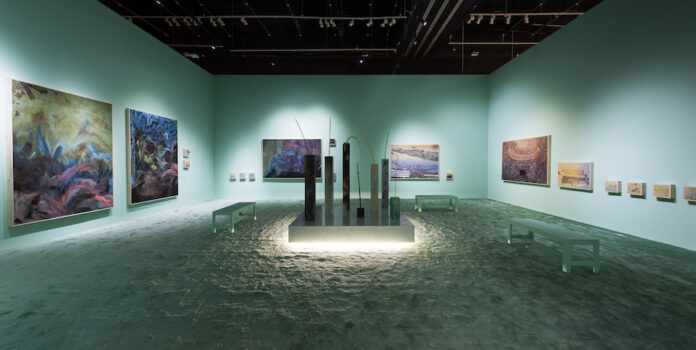DUBAI: A woman dressed in black with a light blue colored sack over her head moves gracefully amidst a dark forest — she holds in either hand a branch with white feathers. The video work, executed in 2021 and titled “Too Close to the Sun,” is by Emirati artist Maitha Abdalla and it is on display in “Beyond: Emerging Artists,” which wraps up on Dec. 4 in Abu Dhabi’s Manarat Al-Saadiyat.
The exhibition kicked off as part of the wider Abu Dhabi Art fair that ended Nov. 21. Curated by Sam Bardaouil and Till Fellrath, “Beyond: Emerging Artists” explores the challenges of the future and painful reminders of the past while highlighting three UAE-based artists.
Alongside Abdalla’s showcase are rooms featuring work by Emirati Hashel Al-Lamki and American Christopher Benton, who is based in Dubai.
A view of the room of Emirati artist Maitha Abdallah in Beyond: Emerging Artists, a section at this year’s now concluded Abu Dhabi Art fair running until Dec. 4th. Courtesy of Abu Dhabi Art
Bardaouil and Fellrath told Arab News that the three artists’ strong links with Abu Dhabi allowed them to examine the city’s history and diversity, as well as its challenges and opportunities.
“Throughout our curatorial practice we have always been closely connected to the art scene in the Gulf region, and to the UAE in particular,” Bardaouil and Fellrath told Arab News. “Each of the three artists are either from Abu Dhabi or have been based here for a very long time. It was important to us that there is a strong connection to the city the works are exhibited in, to its history and diversity, as well as to its challenges and opportunities.”
The artists rely on media ranging from painting to sculpture, soundscapes, video works, found objects and site-specific installations.
The core focus of the program is on mentorship. Its aims thus venture outside the traditional role of a curator. “We wanted to work with artists where we felt we could contribute to the development of their practice,” said Bardaouil and Fellrath. “It was important to us to give each artist their own distinct voice and offer them the freedom and support to develop a project that they already had on their mind. Each of the three artists pushed their initial ideas to create truly immersive installations that are made up of different individual components.”
Abdalla’s commissions are part of a series of works that “negotiates the wild nature of women that social forces have often attempted to tame,” according to the artist.
In her room, Abdalla recreated US psychoanalyst Pinkola’s “wild creature” through her immersive installation. The visitor walks into an immersive space with a window that looks outdoors where there is a video of a performance where the performer, Abdalla, is attempting different poses of Pinkola’s “wild woman.”
“In my work, I am interested in storytelling and folk tales, and for this exhibition I was inspired by the book ‘Women Who Run with the Wolves,’ by Clarissa Pinkola Estes, an American psychoanalyst. She talks about how in every woman there is a wild creature and that this creature is powerful. She calls it wild woman and says this creature is an endangered species,” Abdalla said.
“Maitha’s work is amazing–from performances that revolve around notions of female wildness (characterized by a quasi-mythological woman, Sila) to sculptures and paintings that provoke thought and discussion around what’s considered right and wrong behavior and thought in communities,” Fair Director Dyala Nusseibeh told Arab News. “She reminds me in some ways of Paula Rego in the intensity of her paintings.”
Each room is conceived as an immersive space through which visitors can delve into each artist’s work, practice and personal life. The walls and tiles of Abdalla’s room are painted pink, for example, to recall her childhood bathroom. As Nusseibeh says, “the ambitious claiming of each room” by the artists provides a unique portal into their world.
Hashem Al-Lamki, Neptune. Courtsey of Abu Dhabi Art
Benton’s installation of a chained palm tree also fosters debate around labor economies and the appropriation of Middle Eastern culture in the US.
Christopher Joshua Benton, chained palm tree installation. Courtsey of Abu Dhabi Art
The artist’s film “The Kite Has Come” features archival images of Zanzibar from 1860-1910 — when the world’s last slave market operated in the city — and explores how slave histories in past centuries resonate in today’s world.
What profoundly resonates with the visitor even after they have left the room is how Benton’s work remembers the presence of the East African diaspora in the Gulf and the in-depth thought he has given to slave histories and how their stories over the last few centuries continue in today’s world.
Al-Lamki’s room on the other hand, entirely painted in a mystical soft blue, looks at the rapid pace of transformations shaping the UAE today, particularly evident in the building up of his hometown of Al-Ain.
The artist, who founded the art group Bait 15 in a residential neighborhood in downtown Abu Dhabi, uses natural pigments collected from regional locations, referencing traditions that are under threat from new technologies and consumerism.
“The extravagance of the glitter and dyes in his paintings alongside the use of batteries, star stickers and popcorn in his sculpture, contribute to a sense of spectacle and futurism, but also a note of wistfulness for what is left behind,” Nusseibeh said.
What is so poignant about the works by each of the artists is that they go beyond of their formal, physical realm as art to tell the stories of their creators and the past and present histories of the world around them.
As an overall exhibition, the three rooms offer immersive solo shows covering each artist’s diverse practices within the context of their shared relationship to the UAE, its past and present histories and rapidly unfolding future.

